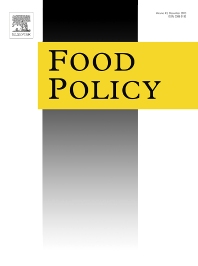Last updated on February 8, 2014
I began a three-year term as associate editor over at Food Policy at the end of last year, which means that I handle submissions in my areas of expertise, deciding which manuscripts get reviewed and which ones get desk rejected, selecting reviewers for those manuscripts that do get reviewed, and so on.
Once again, I wanted to feature a few articles from the latest issue of the journal. There is nothing special about those articles beyond the fact that I thought they would be of interest to readers of this blog. Those are also regular articles–there is an entire special section of this latest issue dedicated to impact assessment in agricultural research, which you should check out.
Changing asset endowments and smallholder participation in higher value markets: Evidence from certified coffee producers in Nicaragua, by Jason Donovan and Nigel Poole.
Highlights:
- Most households built elements of their asset base, and increased their resilience to shocks.
- But they also struggled to make effective use of the gains to intensify their livelihoods.
- Paper highlights household heterogeneity in asset endowments and its implications for rural development.
- Poverty reduction through market-related interventions requires that the underlying constraints on household investments be addressed.
The politics of success in the fight against malnutrition in Peru, by Andres Mejia Costa and Lawrence Haddad.
Highlights:
- Government success in reducing stunting resulted from greater policy coordination.
- Pooled nutrition funding enhanced incentives for institutional coordination.
- Longer term commitment to nutrition was reinforced through electoral campaigning.
- Civil society pushed nutrition advocacy and monitoring efforts through a coordination platform.
- Nutrition targets became binding when linked to poverty reduction strategies.
Faltering fisheries and ascendant aquaculture: Implications for food and nutrition security in Bangladesh, by Ben Belton et al.
- We analyze data on fish consumption in Bangladesh collected in 1996/7 and 2006/7.
- Consumption of fish from capture fisheries declined, particularly for the poorest.
- Total fish consumption was maintained across all income groups due to aquaculture growth.
- Contribution of essential micronutrients from fish may have declined for the poorest income groups.
- Aquaculture’s contribution to food security has only partially offset capture fisheries losses.
Policy coherence and food security: The effects of OECD countries’ agricultural policies, by Jonathan Brooks
- More coherent agricultural policies can strengthen global food security.
- The spill-over effects of OECD countries’ agricultural policies have declined.
- OECD countries should replace trade-distorting instruments with targeted alternatives.
- Structurally higher food prices have changed the policy landscape.
- The coherence of emerging economies’ agricultural policies is increasingly important.
Got milk? The impact of Heifer International’s livestock donation programs in Rwanda on nutritional outcomes, by Rosemary Rawlins et al.
Highlights:
- Heifer International’s livestock donation programs in Rwanda have favorable impacts.
- Households that receive a dairy cow consume a more diverse diet than non-recipients.
- Children in those households exhibit improved height- and weight-for-age measures.
- Households that receive a dairy cow have nearly triple the dairy consumption of control households.
- Households that receive a goat have nearly double the meat intake of control households.
- Children in those households exhibit improved weight-for-height and weight-for-age measures.
